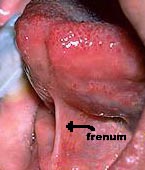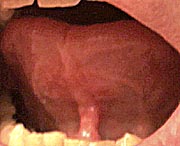
Adult lingual frenum

My Lingual Frenectomy: What it's like to have a lingual frenectomy and what to expect from it.
Important Notice!
I
am not a doctor and have no medical
training of any kind.
Nothing
on this page is intended as a recommendation for or
against
having a lingual frenectomy. It is only a chronicle of
my
experiences and may have no relevance to anyone else.
What is Tongue Tie or Ankyloglossia?
Depending on the reference, between two and five percent of all babies are born with some degree of tongue tie (ankyloglossia) where the thin sheet of flesh (lingual frenum, or frenulum) that connects the underside of the tongue to bottom of the mouth prevents the tongue from protruding from the mouth.

Adult
lingual frenum
This can be caused by the frenum being too short or extending too far toward the tip of the tongue. In serious cases babies may not be able to suckle properly and if left uncorrected will lead to speech problems. Minor cases can be left uncorrected and the individual will live a completely normal and fully functional life. Many people have some degree of tongue tie and never know it. As long as the degree of tongue tie in a child is small enough that it doesn't interfere with feeding or speech many doctors prefer to leave it alone. Sometimes the severity of the condition diminishes as the individual matures.
I belong to the group of people with minor tongue tie. Although it never caused me any problems it was nonetheless one of those minor annoyances that I finally decided to have corrected.
Determining
the Degree of Tongue Tie:
The first thing I had to determine was how tongue tied was I and how much would having a lingual frenectomy, the name of the operation to correct it, would improve my condition. The answer to the first question turned out to be very difficult to determine.
One measure for determining the degree of tongue tie is how far an individual can stick out his or her tongue as measured from the front of the lower teeth to the tip of the tongue. In my case this was 16 mm, about 5/8-inch. On-line references suggested that anything less than 15 mm was borderline for causing problems. The problem came when I tried to find out how far the average, non-tongue tied person could stick out his or her tongue. Neither my dentist nor my oral surgeon knew. (The oral surgeon was himself surprised that such a simple question had never been answered.) Hours of Googling using numerous key word combinations failed to turn up a number. I decided the only way to get a feel for this was to conduct my own survey. I talked half a dozen friends and family into measuring how far they could stick their tongues out. The average was 27 mm, just barely over one inch. I'll be the first to admit that the sample space was much too small to be significant. However, it serves as a rough guideline in as much as there weren't any authoritative references to use.
With 27 mm as a guide, I now knew that my degree of tongue tie created a 40-percent below normal extension length.
During the initial consultation with my oral surgeon, he stated that I could expect an increase of 1/4 to 1/2-inch. Since the procedure was quick and inexpensive I decided to have it done.
The
Operational Procedure:
The lingual frenectomy was preformed in the oral surgeon's office under local anesthetic. It only took ten minutes. The procedure was completely painless. Having my teeth cleaned at the dentist's office is more uncomfortable.
The operation involved clamping the frenum behind the flesh to be removed, cutting away the leading edge of the frenum and closing the incision with dissolving stitches. After the operation a nurse packed the area under my tongue with cotton gauze to absorb any minor bleeding and instructed me to replace the gauze every half hour until the spotting stopped. I was told to avoid eating anything until this occurred and then to eat only very soft foods that did not require chewing. Additionally, I was told to avoid using straws or doing anything that might create suction because that would tend to draw blood out of the incision. After 24 hours I was supposed to rinse my mouth out with salt water several times a day. They gave me a prescription for penicillin and 500mg Vicodin caplets and sent me home.
Healing:
I believe there is a balance in nature. If you win big in one area you can expect to pay somewhere else. In that case of my lingual frenectomy the operation was a cake walk, the healing was a nightmare.
Three hours after getting home the local anesthetic had completely worn off and I was in misery. The incision hurt like the sharp pain of a paper cut, the entire area around it was swollen and the gauze abraded these tender areas, the pain radiated throughout the jaw area causing considerable muscle soreness and a severe headache. I tried one of the Vicodins and while it got rid of the headache and reduced some of the minor aches, it didn't seem to do anything for the sharp pain around the incision. Eating was extremely painful. Things continued like this for 36 hours. Needless to say I didn't get much sleep that night.
I tried using an over the counter oral anesthetic containing 20-percent benzocaine applied to the gauze to reduce the pain but it didn't help.
During this period I learned a few tricks that reduced, but didn't eliminate, some of the pain. First I discovered that in my case the amount of blood leaking from the incision was very little. Therefore I didn't need a huge mass of gauze like the one initially packing under my tongue. I found that a small square measuring 1-inch on an edge, folded into quarters was plenty to blot any leakage. This small volume prevented it from pressing against and irritating the tender areas around the incision. I continued using these small pads long after the spotting stopped because they provided padding that prevented the stitches from poking into the underside of the tongue. A long, thin tweezers made removing and replacing the gauzes easy and avoided the risk of touching the area with my fingers, which was painful and potentially unsanitary.
I quickly learned that I could eat soft foods like oatmeal almost painlessly by placing small spoonfuls on the back of my tongue. Anything placed near the front of the tongue automatically brought the tip of the tongue painfully into action. I found peanut butter to be extremely painful to eat. It's so sticky that no matter where it's placed in the mouth the tongue is forced into all sorts of painful maneuvers to get it swallowed. Scrambled eggs were okay. Chicken soup was particularly comforting. Chewing bread was a nightmare.
By the end of the second day the worst of the pain was over. All that was left was a dull ache and some soreness. There was still considerable swelling so I continued with the gauze pads.
By the end of the first week I was pretty much back to normal. I could eat almost any food I wanted without pain. The incision was still very tender. Any attempts to see how far I could stick out my tongue resulted in the incision rubbing painfully against the sharp edge of my bottom teeth. This ended up greatly slowing the healing process. Just as with a cut to the skin, a scab formed over the incision. The scab covers and protects the area so it can heal. Every time I stuck my tongue out, no matter how carefully I did it, the scab was abraded, torn or scratched away. I estimate doing this just two or three times during the second week of healing doubled the length of time to complete recovery to four weeks. If I had it to do over again I would keep my tongue flat on the floor of my mouth for at least the first two weeks.
During the first week I occasionally experienced a tingling sensation almost like a mild electrical shock just under the tip of my tongue. These sensations faded completely by the end of the third week.
By the end of the third week I was 90-percent healed. Sticking my tongue out as far as it would go created an uncomfortable stretching sensation like something was on the verge of tearing. By the end of the forth weak this was gone.
Final
Results:
My lingual freedom increased the length I could stick my tongue out from 16mm to 28mm, or 1/2-inch. This may not sound like much of an improvement but it has to be remembered that the frenum isn't the only thing that determines how far out a tongue can be extended. The length of the tongue itself is the most important factor. Visually there isn't much difference. A close look at the frenum now shows that the thick band of white tissue on the leading edge of the frenum is now gone.

Because the underside of the mouth is filled with glands there is limit as to how much of the frenum can be safely removed. I found it important to discus this with my oral surgeon ahead of time to insure I got the results I hoped for. Functionally I haven't noticed any significant difference. Psychologically I feel much better both because a deficiency has been corrected and because I had the resolve to do so.
Costs:
How much a lingual frenectomy costs varies considerably with location and time. In southern California in 2008, my initial consultation with an oral surgeon cost $66. The operation and followup examination two weeks later were combined for $325. However, this was after the economic crash in Fall of 2008 so the doctor may have reduced his asking price for this sort of elective surgery.
Final
Thoughts:
Although the amount of correction I obtained from my lingual frenectomy may not seem like much, I feel I got my money's worth and that for me the psychological benefits justified enduring the month of discomfort.
(Click
on main site
to browse 100 other topics ranging from exotic kaleidoscope designs
to the strange world of lucid dreaming.)